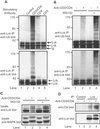Negative regulation of Lck by Cbl ubiquitin ligase
- PMID: 11904433
- PMCID: PMC122603
- DOI: 10.1073/pnas.062055999
Negative regulation of Lck by Cbl ubiquitin ligase
Abstract
The Cbl-family ubiquitin ligases function as negative regulators of activated receptor tyrosine kinases by facilitating their ubiquitination and subsequent targeting to lysosomes. Cbl associates with the lymphoid-restricted nonreceptor tyrosine kinase Lck, but the functional relevance of this interaction remains unknown. Here, we demonstrate that T cell receptor and CD4 coligation on human T cells results in enhanced association between Cbl and Lck, together with Lck ubiquitination and degradation. A Cbl(-/-) T cell line showed a marked deficiency in Lck ubiquitination and increased levels of kinase-active Lck. Coexpression in 293T cells demonstrated that Lck kinase activity and Cbl ubiquitin ligase activity were essential for Lck ubiquitination and negative regulation of Lck-dependent serum response element-luciferase reporter activity. The Lck SH3 domain was pivotal for Cbl-Lck association and Cbl-mediated Lck degradation, with a smaller role for interactions mediated by the Cbl tyrosine kinase-binding domain. Finally, analysis of a ZAP-70-deficient T cell line revealed that Cbl inhibited Lck-dependent mitogen-activated protein kinase activation, and an intact Cbl RING finger domain was required for this functional effect. Our results demonstrate a direct, ubiquitination-dependent, negative regulatory role of Cbl for Lck in T cells, independent of Cbl-mediated regulation of ZAP-70.
Figures






Similar articles
-
Perturbed regulation of ZAP-70 and sustained tyrosine phosphorylation of LAT and SLP-76 in c-Cbl-deficient thymocytes.J Immunol. 1999 Jun 15;162(12):7133-9. J Immunol. 1999. PMID: 10358158
-
The oncogenic 70Z Cbl mutation blocks the phosphotyrosine binding domain-dependent negative regulation of ZAP-70 by c-Cbl in Jurkat T cells.Mol Cell Biol. 1999 Oct;19(10):6652-64. doi: 10.1128/MCB.19.10.6652. Mol Cell Biol. 1999. PMID: 10490604 Free PMC article.
-
TULA: an SH3- and UBA-containing protein that binds to c-Cbl and ubiquitin.Oncogene. 2004 Jun 10;23(27):4690-706. doi: 10.1038/sj.onc.1207627. Oncogene. 2004. PMID: 15107835
-
The Cbl family of ubiquitin ligases: critical negative regulators of tyrosine kinase signaling in the immune system.J Leukoc Biol. 2002 May;71(5):753-63. J Leukoc Biol. 2002. PMID: 11994499 Review.
-
The role of competing mechanisms on Lck regulation.Immunol Res. 2020 Oct;68(5):289-295. doi: 10.1007/s12026-020-09148-2. Epub 2020 Aug 14. Immunol Res. 2020. PMID: 32794043 Review.
Cited by
-
Beyond the Cell Surface: Targeting Intracellular Negative Regulators to Enhance T cell Anti-Tumor Activity.Int J Mol Sci. 2019 Nov 20;20(23):5821. doi: 10.3390/ijms20235821. Int J Mol Sci. 2019. PMID: 31756921 Free PMC article. Review.
-
Cbl enforces an SLP76-dependent signaling pathway for T cell differentiation.J Biol Chem. 2009 Feb 13;284(7):4429-38. doi: 10.1074/jbc.M808679200. Epub 2008 Dec 11. J Biol Chem. 2009. PMID: 19074136 Free PMC article.
-
Strategies to enhance NK cell function for the treatment of tumors and infections.Crit Rev Immunol. 2018;38(2):105-130. doi: 10.1615/CritRevImmunol.2018025248. Crit Rev Immunol. 2018. PMID: 29953390 Free PMC article. Review.
-
Microclusters as T Cell Signaling Hubs: Structure, Kinetics, and Regulation.Front Cell Dev Biol. 2021 Jan 26;8:608530. doi: 10.3389/fcell.2020.608530. eCollection 2020. Front Cell Dev Biol. 2021. PMID: 33575254 Free PMC article. Review.
-
Dasatinib-resistant universal CAR-T cells proliferate in the presence of host immune cells and exhibit antitumor activity.Mol Ther. 2025 Apr 2;33(4):1535-1551. doi: 10.1016/j.ymthe.2025.02.012. Epub 2025 Feb 11. Mol Ther. 2025. PMID: 39935177 Free PMC article.
References
-
- Latour S, Veillette A. Curr Opin Immunol. 2001;13:299–306. - PubMed
-
- Gupta S, Weiss A, Kumar G, Wang S, Nel A. J Biol Chem. 1994;269:17349–17357. - PubMed
-
- Molina T J, Kishihara K, Siderovski D P, van Ewijk W, Narendran A, Timms E, Wakeham A, Paige C J, Hartmann K U, Veillette A, et al. Nature (London) 1992;357:161–164. - PubMed
-
- Groves T, Smiley P, Cooke M P, Forbush K, Perlmutter R M, Guidos C J. Immunity. 1996;5:417–428. - PubMed
Publication types
MeSH terms
Substances
Grants and funding
LinkOut - more resources
Full Text Sources
Other Literature Sources
Molecular Biology Databases
Research Materials
Miscellaneous

